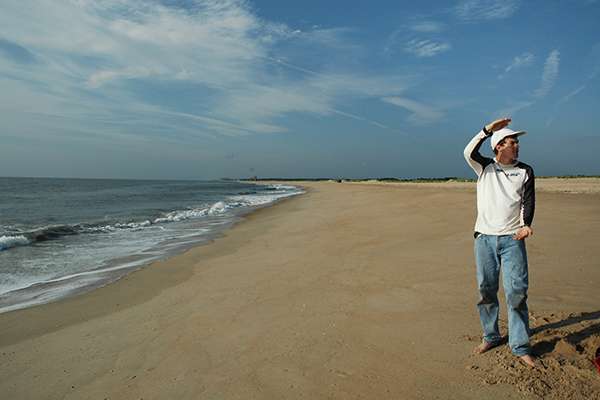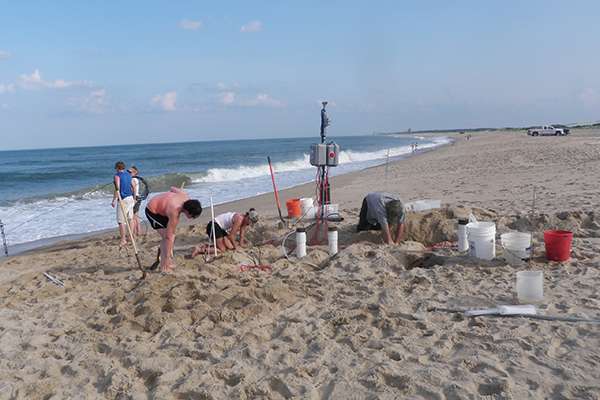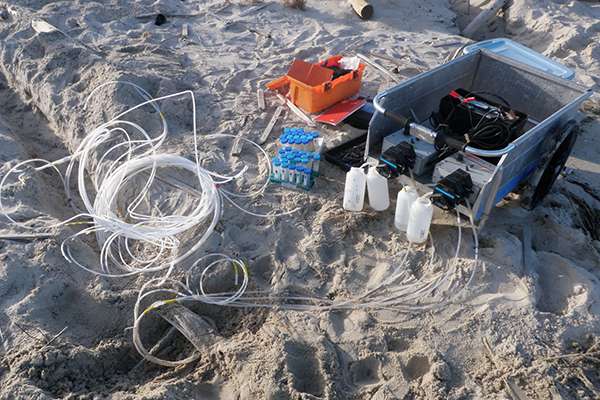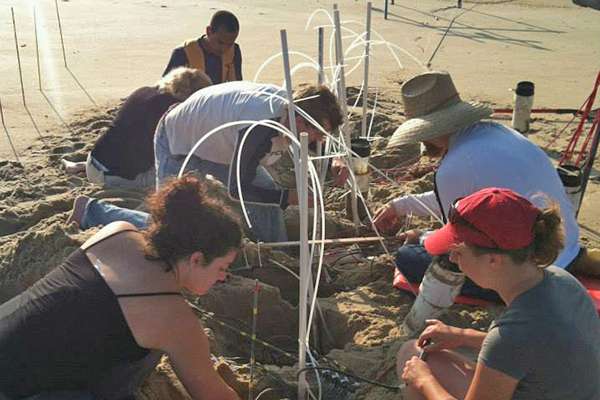Researchers study reactions that occur when groundwater, saltwater meet in coastal aquifers

If you've ever floated through a cold patch of water while swimming in the ocean, you've experienced a phenomenon called submarine groundwater discharge (SGD).
SGD occurs when groundwater seeps out of the seabed into the coastal ocean. SGD is often brackish as a result of fresh groundwater from land mixing with salty ocean water. The mixing of fresh and salty groundwater occurs in the beach aquifer, typically where the waves are breaking.
"That cold spot is groundwater that's been in the ground for tens to hundreds of years and has seeped up into coastal waters," explains James Heiss, a doctoral candidate studying coastal hydrogeology in University of Delaware's Department of Geological Sciences.
Advised by Holly Michael, Unidel Fraser Russell Chair for the Environment and associate professor of geology, Heiss is studying how tides and waves affect the way groundwater flows and distributes solutes in coastal aquifers. He is particularly interested in the "mixing zone" that is created below the beach surface when freshwater and saltwater come together to drive biogeochemical reactions.
Specifically, Heiss is curious about the time scales and factors that affect the size of the mixing zone, the rate at which groundwater flows through this zone, and the chemical reactions that take place there.

So, why is the mixing zone important?
"Fresh groundwater that makes its way to the coastline contains chemicals that are of a much higher concentration than those found in the ocean. In Delaware, for example, fresh groundwater may contain nitrate and other nutrient pollutants that infiltrate into the subsurface from sources like agricultural fields or septic systems," Heiss says.
Beach aquifers serve an important role in controlling how these groundwater nutrients are discharged across the seabed. When freshwater and saltwater mix it can set off important chemical reactions that remove nutrients, like nitrate, from the groundwater before it seeps into the ocean.
But if the mixing zone is too small or if the groundwater flows too fast, the researchers theorize, there might not be enough time for these chemical reactions to occur, leading to extra nutrients being deposited into the ocean ecosystem.
These extra nutrients can lead to water quality problems such as algal blooms, fish kill and, in worst-case scenarios, beach closures.

To test their theory, the research team conducted a yearlong field experiment at Cape Henlopen State Park to see how the mixing zone behaved under different hydrologic conditions and time scales, and to discern the amount of time groundwater flowed through the beach aquifer before discharging to the Delaware Bay.
The team installed 10 multi-level sampling wells along a straight line below the beach surface. They collected water samples over a variety of time-scales ranging from daily (12 hours; tidal cycles) to bi-weekly (14-28 day spring neap cycles), seasonally (changes in recharge to the aquifer due to precipitation) and following storm events (in this case Hurricane Sandy).
Then, they measured the water's salinity, or saltiness, to determine how tides influence the salinity of groundwater in the beach aquifer and used numerical models to validate and support their field results.
"We were trying to get an idea which of those forcing mechanisms – level of tide, size of the tide, or seasonal variability of recharge—are important for controlling the size of the mixing zone," Heiss explains.
What they learned was that the mixing zone was large when the tide level reached high on the beach during spring tide because a lot of seawater infiltrated across the beach. At neap tide, the tide doesn't reach as far inland so there is less seawater infiltration and a smaller mixing zone.

The slope of the beach is also important, Heiss said, but the most important factor influencing the salinity distribution was seasonal changes in precipitation. When the water table was high on land, more freshwater flowed through the system and flushed salt out of the beach.
"James' work shows how dynamic these mixing zones really are, and he is connecting the physics to the biogeochemistry. This will allow us to better manage and predict changes in our coastal ecosystems, especially as our beaches and marshes are impacted by sea-level rise. It makes us realize that important things are happening under our feet as we sit on the beach," says Michael.
The data might provide reasoning for beach managers and engineers to create gentle sloping beaches to create a large mixing zone.
The researchers also discovered that the mixing zone itself is not a stable feature in the subsurface. "It moved around a lot over time scales that, for groundwater, you wouldn't really expect since groundwater moves so slowly," he says.
According to Heiss, this tells the scientists that depending on the speed of the movement, fewer reactions may occur in this mixing zone, which could contribute to the extra nutrients to be deposited into coastal waters.
The study was funded in part by the National Science Foundation and conducted in collaboration with William Ullman, professor of marine science and policy in the College of Earth, Ocean, and Environment, and graduate student Kyra Kim, who focused more on the biogeochemical aspects of the project.
Next steps
The next step in the research is to model common chemical reactions known to occur in this zone, such as denitrification, and further investigate whether there are dynamics that can be controlled, like beach slope, to improve water quality.
The scientists are considering the role biology and chemistry play, too. Microbes, for example, help remove nitrate from the coastal ocean when they eat organic matter found in the ocean and breathe dissolved oxygen in the seawater. They also consume oxygen found in groundwater, and if given enough time, can help convert nitrate into benign nitrogen gas the same way humans convert oxygen to carbon dioxide when they breathe.
"All of these things are important for understanding the biogeochemical framework at work in this mixing zone," Heiss says.
More information: James W. Heiss et al. Coupled surface-subsurface hydrologic measurements reveal infiltration, recharge, and discharge dynamics across the swash zone of a sandy beach, Water Resources Research (2015). DOI: 10.1002/2015WR017395
Journal information: Water Resources Research
Provided by University of Delaware



















